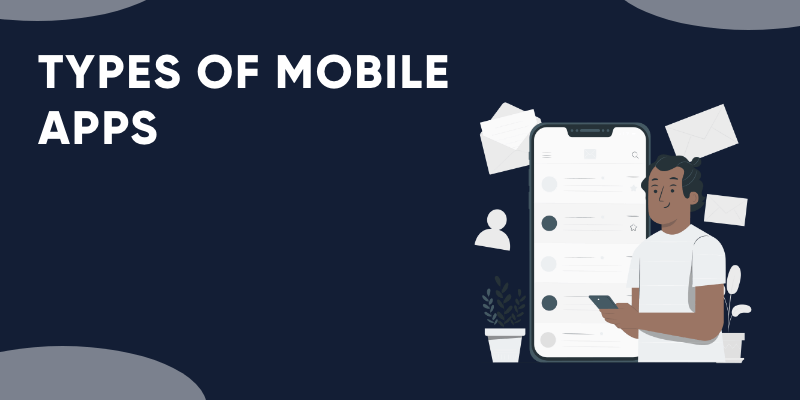The days of only a few people being able to afford a phone with a camera, music player, and touchscreen are long gone. We’ve gone a long way from monochrome phones to digital touchscreen phones with a plethora of capabilities. The smartphone revolution has ushered in the digital era, making it simple to do things on the go. The development of mobile apps is a difficult task. We can accomplish a lot of things on the move by utilizing mobile apps on our phones, tablets, and computers, whether it’s watching movies, reading the news, listening to music, playing games, seeking information, or buying groceries.
The app industry’s goal has become to produce smarter apps as technology improves and becomes more accessible. The app market is always changing and introducing new sorts of apps to improve the user experience.
To develop applications that appeal to a wide range of users, developers must contend with a plethora of operating systems, SDKs, development tools, screen sizes, and form factors, as well as a constantly changing technological landscape.
As if that weren’t enough, there are a variety of approaches to developing mobile apps that development teams must consider before embarking on every new mobile project.
Choosing how to construct a mobile app, on the other hand, can have the most impact on the project’s overall cost, timeline, and success. This is only second to identifying the app’s scope and functionality. Failure to match an app’s needs to the appropriate mobile development strategy almost always results in wasted time and effort, as well as a less effective final outcome.
There are 3 types of Mobile Apps to Develop an App
1. Native Apps
2. Hybrid Apps
3. Web Apps
What Is Native Apps?
Native apps are designed to run on a certain operating system and are built in a native programming language. The majority of smartphones run the Android operating system or if it’s an apple device, the iOS operating system.
Native Apps are designed expressly for a given operating system to take advantage of the features available on the devices that run that operating system. As a result, native programs cannot run on multiple operating systems. To put it another way, you can’t use iOS apps on Android phones and vice versa.
Because they are designed for a certain OS, the programming languages in which they are written are also specialized to that OS. For iOS apps, Xcode and Objective-C are commonly utilized, while Eclipse and Java are commonly used for Android apps.
Native apps are designed to take advantage of all of the phone’s features and tools, such as contacts, cameras, and sensors. These apps provide a high-performance and pleasant user experience because they are built using the native device UI.
The apps can be found in the app stores for each operating system. For example, native Android apps can be found on the Google Play Store, iOS apps on the App Store, and Windows apps on the Microsoft Store, among other places.
Technologies in Native Apps
A plethora of programming languages is used to create native apps. Java, Kotlin, Python, Swift, Objective-C, C++, and React are just a few examples.
Pros
- Native apps have the advantage of being faster and more dependable in terms of performance due to their solitary focus
- They use the device’s resources more efficiently than other sorts of mobile apps. Native apps take advantage of the device’s native user interface, resulting in an enhanced user experience
- Because native apps interact directly with the device’s hardware, they have access to a wide range of functions such as Bluetooth, phonebook contacts, camera roll, NFC, and more.
Cons
- The issue with native apps, on the other hand, is that once you start developing them, you’ll have to duplicate your efforts for every platform
- You cannot utilize code written for one platform on another. As a result, prices rise. Also, the time and effort needed to maintain and improve the codebase of each version
- After then, every time the app is updated, the user must download and reinstall the new file. This also implies that native applications occupy valuable storage space on the smartphone
Examples of Native Mobile Apps
WhatsApp, which was created as a native software for iPhones and Android phones, is a widely used messaging service in many regions of the world. This platform was the fourth most downloaded app in the world in Q3 2020, with over 140 million downloads.
As a result, in terms of corporate communication tools in the office, this native app example is a viable solution.
Spotify
Spotify, a well-known native app example, is one of the must-have applications for music fans to install on their smartphones. It is a digital music service hub that provides users with worldwide access to thousands of songs and podcasts from record labels and media firms.
Apart from that, Spotify is a well-known example of a cloud-native application. Spotify has gained considerable performance efficiency in its workloads thanks to Google Cloud, allowing it to better serve its users.
Magento 2 POS
In the sector of eCommerce, the Magento 2 POS (Point of Sale) is a notable React Native application example. It allows users to effectively manage many physical stores with only a single app on their Android or iOS devices.
Furthermore, the Magento 2 React Native app will provide a user-friendly experience for your cashiers, as they will be able to utilize the app on their tablets without any difficulties.
What Is Hybrid Apps?
Hybrid apps are a blend of native apps and mobile web apps. A hybrid app is essentially a mobile web app covered in a platform-specific shell.
Standard web technologies such as HTML, JavaScript, and CSS are used to create hybrid apps. To overcome the limitations of web apps, developers package and publish the code using platform-specific native “wrappers.”
The native wrappers enable hybrid apps to be installed on devices, deployed through app stores, and accessed via JavaScript using native device APIs.
The hybrid technique enables cross-platform creation of mobile apps, greatly lowering development costs. The key advantage of hybrid apps is that developers can create mobile apps for both platforms at a lesser cost and in less time.
Furthermore, hybrid apps are equal to native apps. In reality, before rebuilding its mobile apps natively, Facebook leveraged hybrid technology to construct some of the world’s most well-known mobile apps, engaging millions of users.
The speed and performance of the web container on every target device is the primary restriction of hybrid apps. As a result, hybrid development is best used when an app’s requirements transcend the boundaries of the web but do not necessitate the full capabilities of the native.
Technologies of Hybrid Apps
Hybrid apps make use of both web technology and native APIs. They are built with Ionic, Objective C, Swift, HTML5, and other technologies.
Pros
- Developing a hybrid app is faster and less expensive than developing a native app. As a result, a hybrid app can serve as the minimal viable product – a way to demonstrate the viability of developing a native app
- They also load quickly, are suitable for use in countries with slower internet connections, and provide users with a consistent user experience. Finally, because they share a single code base, they have far less code to manage
Cons
- Hybrid apps may lack the strength and speed that native apps have
Examples of Hybrid Mobile Apps
The hybrid structure of the Twitter social app is one of the best indicators that the hybrid method is trustworthy and can be effective. This also highlights how well hybrid apps can handle large amounts of traffic. It did, in fact, resolve all drawbacks of a hybrid app, which was primarily discussed for performance difficulties.
Twitter has, in fact, altered consumers’ perceptions about hybrid applications, fueling demand for these apps among enterprises.
Instagram, another of the greatest Hybrid App Examples, is one of the major social media apps, with increased user involvement on a daily basis. It is the ideal site for sharing photos and videos. Instagram can support full data even in offline mode with large media because it is a hybrid app. Interestingly, Instagram’s founder, Facebook, is also a native app.
Uber
It is the most widely used web application on m.uber.com. Uber does not require any introduction because it is already well-known among users as a taxi-booking application. Uber is another great example of a hybrid software, with an intuitive and speedy user interface and simple navigation. The user-friendly hybrid software outperforms its opponent in terms of allowing clients to book taxis without difficulty.
What Is A Web App?
A web app runs in browsers such as Chrome, Safari, or Firefox and does not require downloading from app stores, as do native mobile apps. Web apps also do not consume storage space on the user’s device. Mobile web apps, as opposed to native apps, work on both Android and iOS. They are also web-based and do not necessitate installation on the devices.
Because mobile web applications are accessed via mobile browsers, they are the quickest way to reach mobile users. Unlike native apps, you don’t have to build different apps for different platforms, which saves money and effort in the long run.
Users get easily irritated by performance and usability concerns such as long load times, tiny images, and limited network access.
Mobile web apps, unlike native and hybrid apps, are confined to the functionalities integrated into mobile browsers. They also can’t access some of the device’s hardware, contact list, or send push alerts.
Technologies in Web App
HTML5, CSS, JavaScript, Ruby, and other web programming languages are used to create web apps.
Pros
- Because it’s web-based, there’s no need to tailor it to a certain platform or operating system. This lowers the development costs
- There’s also no need to download anything. They don’t take up as much memory on your device as native apps do, making maintenance a breeze — simply push the update live via the web. The update does not need to be downloaded from the app store
Cons
- However, it’s worth noting that web apps are completely reliant on the device’s browser. There will be features that are available in one browser but not in another, potentially offering consumers different experiences
- They also won’t work totally offline because they’re just shells for websites. Although if they feature an offline mode, they will still require an internet connection to back up your data, provide new data, or refresh what’s on-screen
Examples of Web Apps
Google Docs
One of the best web applications in the world is Google’s office suite. We can use Google Docs to generate documents, save them to our computer or Google Drive account, convert them to PDF, print them, and share them with our colleagues. Most importantly, it allows us to collaborate on the same document with our coworkers.
Another advantage of Google Docs is that we can use it even if we don’t have access to the Internet. When our device is reconnected to the Internet, everything we’ve done will be instantly saved in Google Drive without us having to do anything.
Pixlr.com
One of the best web applications in the world is Google’s office suite. We can use Google Docs to generate documents, save them to our computer or Google Drive account, convert them to PDF, print them, and share them with our colleagues. Most importantly, it allows us to collaborate on the same document with our coworkers.
Another advantage of Google Docs is that we can use it even if we don’t have access to the Internet. When our device is reconnected to the Internet, everything we’ve done will be instantly saved in Google Drive without us having to do anything.
Netflix
The most popular streaming video platform is currently in use. For those who are new to streaming video services, consider them to be similar to an online video store. We may choose what we want to see when we want to see it if we want to pause it and watch it later on these platforms.
Netflix gives its subscribers the freedom to watch their favorite shows and movies whenever they want, with no restrictions on time or schedules. Furthermore, because Netflix is a cross-platform service that works with all operating systems, it doesn’t matter where the user is when he wants to watch some of its content.
Differences Between Native & Hybrid
| On the basis of | Native App | Hybrid App |
|---|---|---|
| Installation | Installation is required for native apps | These apps do not need to be installed |
| Maintenance | They require high maintenance | They require less maintenance |
| Time and cost | To design a native application that is compatible with numerous platforms, a substantial budget is necessary (such as iOS and Android) | Hybrid apps are less expensive, or more accurately, cost-effective because they take less time to design |
| Codebase | They have multiple codebases | They have a single codebase |
| User experience | They provide the best user experience | The user experience with hybrid apps is poor comparatively |
| Platform Dependent | These applications were for a single platform | Hybrid apps can run on a number of different platforms. It means they can work on both iOS and Android devices |
| Update | The play store or the app store is helpful to update mobile native apps | Updates for mobile web apps, on the other hand, are centralized |
How To Choose The Best One For App Development?
Native platform developers are hard to get and expensive to hire. You’d need a separate skill set on each platform. A mobile web app or a hybrid app comes into picture when you want your app to reach a broad audience across platforms. These enable cross-platform code reuse.
If your application demands high-resolution visuals, such as in gaming, or complete access to device features or UI control, native apps are the way to go. In fact, if your application is solely intended for a single platform, such as iOS, becoming native is a good idea.
React Native, NativeScript, Xamarin, and other frameworks can be used to achieve native performance while reusing as much code as feasible across platforms.
What you choose should be based on the technology’s maturity and support, as well as the skill sets you have on hand. C# and.NET developers, for example, can use Xamarin, while JavaScript developers can use React Native or NativeScript.
In Conclusion
Now, the optimal approach for mobile app development is entirely dependent on the target audience, business needs, and budget. As a result, while there is no “correct way” to construct each mobile app, the advantages and disadvantages of each approach will help you choose the best app development strategy.
Echoinnovate IT‘s developers have experience with all three types of mobile app development. Furthermore, with over a decade of expertise, we are one of the leading mobile app development companies. Get in touch with our specialists right now to put your plan into action!
FAQs
How should I develop my app over time?
You should be able to envision how your app will evolve over time. The feedback that app developers receive from users who have spent time using the app is one of the best indicators for app developers. As the app developer, you must act quickly to address these issues.
Of course, the key is to remain flexible and open to new ideas. This necessitates conducting a study and putting your results to the test. You will always be able to design your software in such a way that it will provide value to its end customers as long as you can determine what they require.
What monetization methods are the best ones at present?
- Advertising
- Affiliate Marketing
- App Data Monetization
- Freemium Model
- Implementation of Virtual Currencies
Who should I be targeting?
Another important question in user acquisition is demographics, which has a single-word answer. You’ll never be in question about who you should be targeting if you learn everything there is to know about your clients. You should pay special attention to their age, location, issues, and time spent using your app, among other things.



